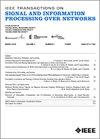Graph Laplacian Learning With Exponential Family Noise
IF 3
3区 计算机科学
Q2 ENGINEERING, ELECTRICAL & ELECTRONIC
IEEE Transactions on Signal and Information Processing over Networks
Pub Date : 2025-03-26
DOI:10.1109/TSIPN.2025.3572698
引用次数: 0
Abstract
Graph signal processing (GSP) is a prominent framework for analyzing signals on non-Euclidean domains. The graph Fourier transform (GFT) uses the combinatorial graph Laplacian matrix to reveal the spectral decomposition of signals in the graph frequency domain. However, a common challenge in applying GSP methods is that in many scenarios the underlying graph of a system is unknown. A solution in such cases is to construct the unobserved graph from available data, which is commonly referred to as graph or network inference. Although different graph inference methods exist, they are restricted to learning from either smooth graph signals or with simple additive Gaussian noise. Other types of noisy data, such as discrete counts or binary digits, are rather common in real-world applications, yet remain under-explored in graph inference. In this paper, we propose a versatile graph inference framework for learning from graph signals corrupted by exponential family noise. Our framework generalizes previous methods from continuous smooth graph signals to various data types. We propose an alternating algorithm that jointly estimates the graph Laplacian and the unobserved smooth representation from the noisy signals. We also extend our approach to include an offset variable which models different levels of variation of the nodes. Since real-world graph signals are frequently non-independent and temporally correlated, we further adapt our original setting to a time-vertex formulation. We demonstrate on synthetic and real-world data that our new algorithms outperform competing Laplacian estimation methods that suffer from noise model mismatch.具有指数族噪声的图拉普拉斯学习
图信号处理(GSP)是分析非欧几里得域信号的重要框架。图傅里叶变换(GFT)利用组合图拉普拉斯矩阵来揭示信号在图频域中的频谱分解。然而,应用GSP方法的一个常见挑战是,在许多情况下,系统的底层图是未知的。这种情况下的解决方案是从可用数据构建未观察到的图,这通常被称为图或网络推理。尽管存在不同的图推理方法,但它们都局限于从光滑图信号或简单的加性高斯噪声中学习。其他类型的噪声数据,如离散计数或二进制数,在实际应用中相当常见,但在图推理中仍未得到充分探索。在本文中,我们提出了一个通用的图推理框架,用于从被指数族噪声破坏的图信号中学习。我们的框架将以前的方法从连续光滑图信号推广到各种数据类型。我们提出了一种交替算法,该算法联合估计图拉普拉斯和噪声信号的未观察光滑表示。我们还扩展了我们的方法,包括一个偏移变量,该变量对节点的不同变化水平进行建模。由于现实世界的图形信号经常是非独立的和时间相关的,我们进一步将我们的原始设置调整为时间顶点公式。我们在合成和现实世界的数据上证明,我们的新算法优于受噪声模型不匹配影响的竞争拉普拉斯估计方法。
本文章由计算机程序翻译,如有差异,请以英文原文为准。
求助全文
约1分钟内获得全文
求助全文
来源期刊

IEEE Transactions on Signal and Information Processing over Networks
Computer Science-Computer Networks and Communications
CiteScore
5.80
自引率
12.50%
发文量
56
期刊介绍:
The IEEE Transactions on Signal and Information Processing over Networks publishes high-quality papers that extend the classical notions of processing of signals defined over vector spaces (e.g. time and space) to processing of signals and information (data) defined over networks, potentially dynamically varying. In signal processing over networks, the topology of the network may define structural relationships in the data, or may constrain processing of the data. Topics include distributed algorithms for filtering, detection, estimation, adaptation and learning, model selection, data fusion, and diffusion or evolution of information over such networks, and applications of distributed signal processing.
 求助内容:
求助内容: 应助结果提醒方式:
应助结果提醒方式:


